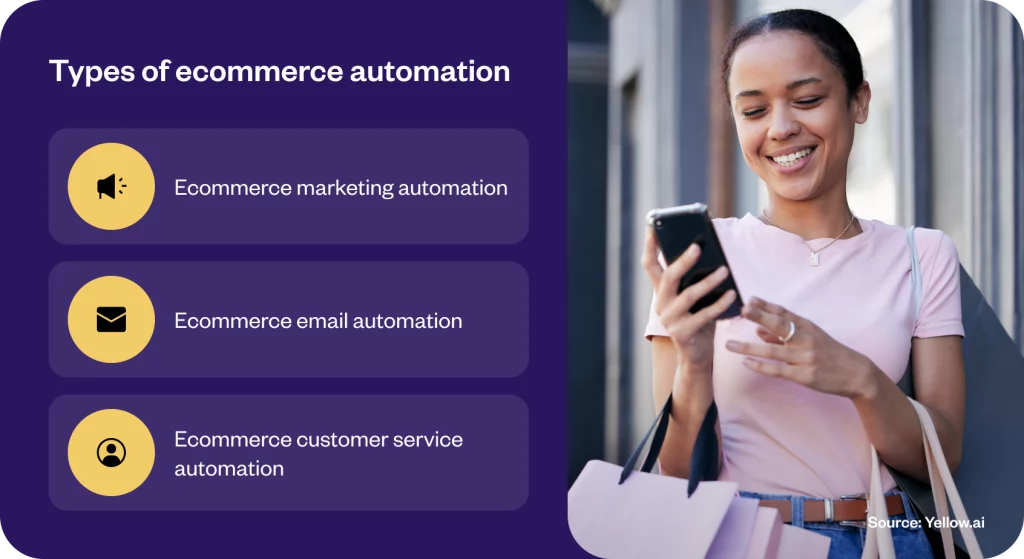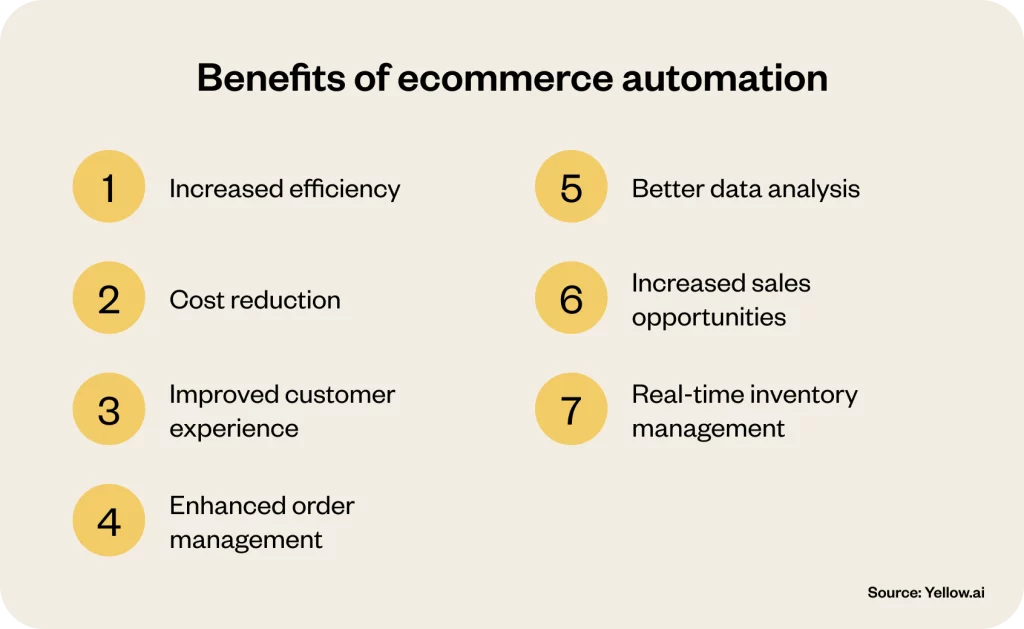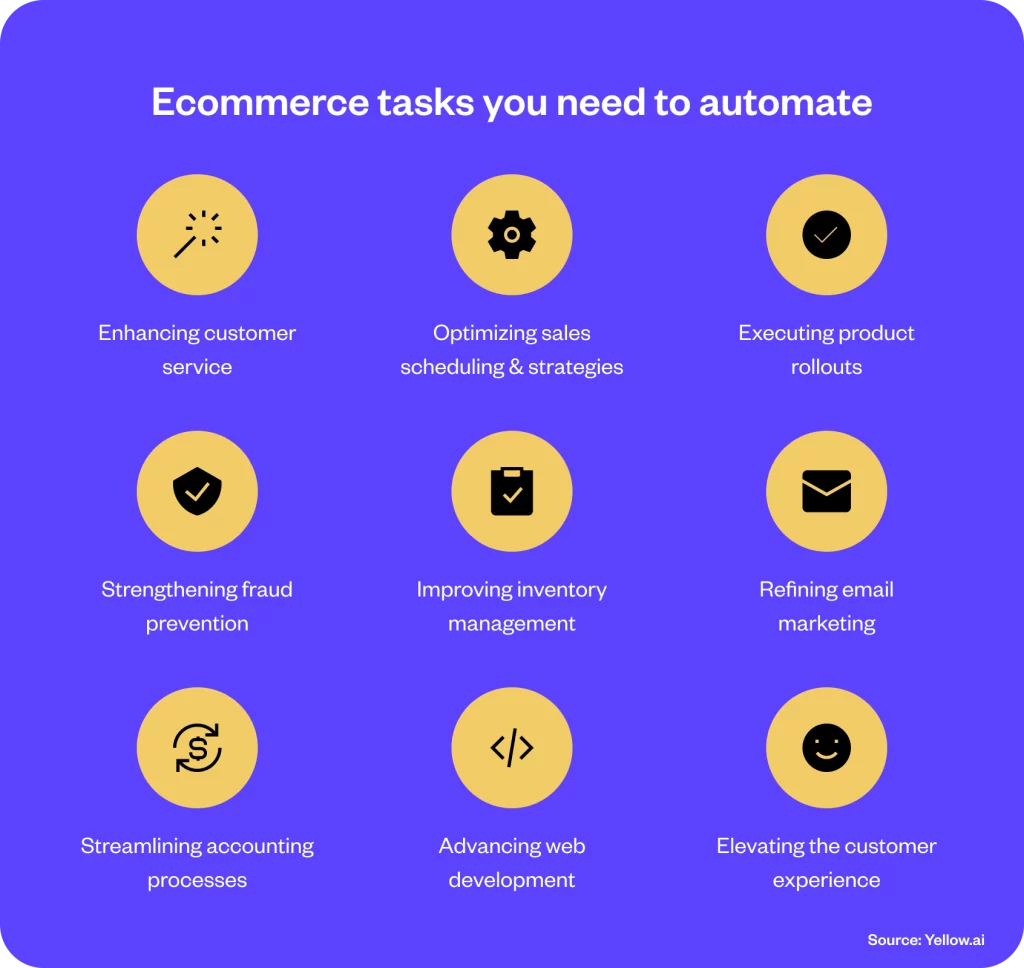Executive summary
Dive into the heart of ecommerce efficiency with our blog on ecommerce automation. From streamlining store operations with ecommerce automation software to leveraging ecommerce marketing automation for unparalleled growth, this blog unpacks the essentials. Discover what ecommerce automation can do for your business, transforming everyday tasks into automated, strategic advantages that drive sales and enhance customer experiences.
Let’s face it: running an ecommerce business is like juggling. You have got hundreds of tiny tasks that, on their own, seem harmless. But let them pile up, and you are looking at a mountain of time-wasters that could have been spent brewing up your next big idea. Deloitte‘s got it right when they say focusing on the big picture is where your head should be, not buried in the sand of the day-to-day.
Ecommerce automation is your ticket to ditching the daily grind of repetitive tasks. Imagine a world where your system knows what your customers want before they do, where inventory manages itself, and marketing campaigns run like clockwork, all without you lifting a finger. It is not some far-off dream; it is what today’s tech offers. It gives you back your time to innovate, strategize, and grow. Let us break down how this magic happens and why your ecommerce operation, whether it’s a mom-and-pop shop online or a global powerhouse, can’t afford to skip on automation.
Related must-reads:
- Ecommerce customer service – A guide for 2024
- 10 Best ecommerce platforms for your business in 2024
- Ecommerce chatbot for your business [+Examples]
- Digital commerce – A complete solution on commerce 2024
What is ecommerce automation?
Every second counts in ecommerce. Here, customer satisfaction is the linchpin of success. In this realm, ecommerce automation is the superhero. At its core, ecommerce automation is the strategic application of software, tools, and technologies designed to transform repetitive, mundane tasks into streamlined, automated processes. This innovative approach covers a vast terrain. It includes inventory management, order processing, marketing campaigns, and customer service interactions. That revolutionizes the traditional ecommerce playbook.
The adoption of ecommerce automation is more than just about keeping up with the Joneses. Ecommerce automation is a game-changer for businesses aiming to elevate their operational efficiency and productivity. By automating routine tasks, businesses liberate their human capital to dive deep into strategic initiatives and creative endeavors. This shift bolsters efficiency and also ensures a more consistent and flawless customer journey. It significantly reduces the margin for error that all too often accompanies manual processes. The ripple effect of implementing automation is profound. It offers a seamless, error-minimized experience that can significantly enhance customer satisfaction and loyalty.
Beyond the immediate benefits of time savings and operational accuracy, ecommerce automation stands as a scalable ally for businesses in growth mode. With automation, the daunting challenge of scaling (managing an uptick in orders, customer inquiries, and the like) becomes manageable without the proportional increase in staffing typically required. This scalability ensures that businesses can expand their reach and capabilities while maintaining operational excellence. However, it is crucial to navigate the automation journey with a balanced approach. It ensures that the quest for efficiency doesn’t compromise the personal touch that customers cherish. Strategic, thoughtful automation, complemented by human insight and creativity, is the golden ticket to succeeding in today’s competitive ecommerce arena. It sets the stage for a future where businesses not only survive but flourish.
Types of ecommerce automation
With the digital marketplace evolving at breakneck speed, understanding the types of ecommerce automation avenues becomes crucial for any ecommerce venture. Let’s explore the three pivotal types of ecommerce automation:

1. Ecommerce marketing automation
Standing out in today’s competitive ecommerce market requires more than just showing up. With ecommerce marketing automation, you do not bombard your customers with messages. Instead, you craft the right message for the right person at the right time. This type involves using sophisticated software to manage and execute marketing tasks, from targeted email campaigns to social media management and beyond, with unparalleled precision.
The modern shopper’s journey is anything but linear, making it challenging for businesses to engage their audience consistently. Marketing automation allows you to weave a personalized narrative across various touchpoints. It ensures that your brand resonates with consumers at every step. By automating routine marketing tasks, companies can allocate resources towards innovation and strategy. It enhances their market position. Furthermore, it ensures a cohesive brand experience, driving engagement and fostering loyalty among your customer base.
Start by segmenting your audience based on their interactions and preferences. Then, leverage automation tools to deliver customized content, from personalized email marketing campaigns to targeted social media ads, ensuring each message is relevant and timely.
2. Ecommerce email automation
Email remains one of the most effective channels for customer engagement and conversion. Ecommerce email automation transforms this traditional tool into a
for personalized communication. It is about turning every email into a personal conversation, whether it’s a welcome message, order confirmation, or a nudge about an abandoned cart.
One size fits all? Not anymore. The challenge lies in making each customer feel unique. Email automation addresses this by sending tailored messages triggered by specific customer actions. That makes every communication feel personal and relevant. Automated emails drive conversions by delivering the right message at the right moment. They can nurture leads and re-engage customers. This strategic approach boosts open rates and click-through rates, translating into higher sales and customer loyalty.
Implement triggered email sequences for actions like cart abandonment or product views. Use data to personalize messages, ensuring content speaks directly to the customer’s needs and interests. Monitor and tweak based on performance metrics for continuous optimization.
3. Ecommerce customer service automation
Immediate gratification is the norm in today’s world. Ecommerce customer service automation ensures your brand meets expectations without compromising the human touch. This facet automates common customer inquiries and tasks. It allows your team to focus on complex issues that require a personal touch.
Related read: Customer Service Automation – Benefits and Examples
The digital age customer expects fast and efficient service round the clock. Automating routine inquiries meets these expectations and frees up your team to tackle more challenging tasks. That enhances overall service quality. By automating basic service tasks, businesses can scale their customer service efforts without proportionately increasing staff. It leads to faster resolution times, improved customer satisfaction, and, ultimately, loyalty.
Related read: Customer service chatbots: Benefits and examples [2024]
Leverage chatbots for common inquiries and implement self-service options for FAQs. Use automation to route complex issues to the right team members. It ensures customers always feel heard and valued.
Benefits of ecommerce automation
In the whirlwind world of ecommerce, automation is the not-so-secret ingredient for businesses looking to scale, improve efficiency, and ultimately enhance the customer experience. Here’s how leveraging ecommerce automation can fundamentally transform your business:

1. Increased efficiency
Juggling multiple tasks simultaneously can lead to inefficiency and errors. It is a common scenario for ecommerce businesses. Implementing ecommerce automation tools for tasks like order entry, inventory updates, and customer notifications can significantly boost operational efficiency. These tools take on the heavy lifting and allow your team to concentrate on strategy and growth.
Picture a scenario where your online store automatically updates inventory levels as sales occur, eliminating the need for manual stock checks. Besides saving time, it also reduces the risk of human error. That ensures your store operates like a well-oiled machine.
2. Cost reduction
The adage “time is money” holds especially true in ecommerce. High operational costs can eat into profit margins, especially when manual processes require additional staffing or overtime. By automating repetitive tasks, you can streamline your operations and reduce the need for extra labor. It can significantly cut costs.
Imagine automating customer follow-up emails instead of having staff manually send them. This move could save countless hours and resources, directly impacting your bottom line positively.
3. Improved customer experience
Today’s consumers expect quick, seamless interactions at every touchpoint. Automation tools can enhance the customer experience by providing timely responses and personalized interactions, from chatbots that offer instant support to personalized email campaigns that make customers feel valued.
Related read: AI and Automation in Customer Experience
Consider a system that automatically sends a personalized discount code to a customer on their birthday. This small, automated gesture can significantly boost customer loyalty and satisfaction.
4. Enhanced order management
Managing orders efficiently can be daunting, especially during peak sales periods. However, ecommerce automation can streamline the entire order management process, from processing orders to managing shipments. It helps reduce delays and improve accuracy.
Visualize an automated alert system that notifies you when an order is at risk of being delayed. It allows you to address issues and ensure customers remain informed and satisfied proactively.
5. Better data analysis
Manually analyzing sales data, customer behavior, and inventory levels can be time-consuming and prone to errors. Automation tools offer advanced analytics capabilities, providing actionable insights that can drive decision-making and strategy.
Related read: Customer Sentiment Analysis in 2024: How-To Guide
An automated reporting tool could identify best-selling products and customer trends. It will enable you to adjust your inventory and marketing strategies dynamically.
6. Increased sales opportunities
Capturing and converting leads into sales requires timely and personalized marketing efforts. Marketing automation can significantly increase sales opportunities by nurturing leads with personalized content and timely engagements.
Envision an automation platform that segments customers based on their browsing behavior and sends them customized product recommendations, effectively increasing the chances of conversion.
7. Real-time inventory management
Keeping track of inventory in real time can be a logistical nightmare. It can lead to overstocking or stockouts. Real-time inventory management systems automatically update your stock levels. As a result, it provides a clear view of your inventory at all times.
Imagine your ecommerce platform automatically ordering stock when levels are low. It will ensure you never miss a sale due to out-of-stock products.
Ecommerce tasks you need to automate
It has become increasingly clear that some processes are ripe for automation. Automation only elevates efficiency and also ensures that your ecommerce business remains competitive and responsive to the ever-evolving market demands. Let’s explore nine critical ecommerce tasks that stand to benefit significantly from automation.

1. Enhancing customer service
In an always-on digital world, customers expect rapid responses to their queries. Manual handling leads to delays, potentially turning a minor issue into a deal-breaker. Automating customer service with AI chatbots and automated ticketing systems ensures round-the-clock responsiveness. Customers receive instant acknowledgments and solutions, leading to improved satisfaction and loyalty. For instance, imagine a chatbot that instantly provides tracking updates or returns policies, freeing your customer service team to handle more complex queries.
Tips for implementation
- Integrate AI-powered chatbots for 24/7 query resolution.
- Use automated ticketing systems to prioritize and route queries efficiently.
- Implement self-service portals for common customer questions.
2. Optimizing sales scheduling & strategies
The dynamic nature of ecommerce demands frequent sales and promotions, which can be cumbersome to manage manually. Sales automation tools can schedule promotions, manage discounts, and even adjust pricing in real time based on inventory levels or competitor activity. It can maximize profits and efficiency. For example, an automated system that schedules weekend sales, sends targeted promotions to customers, and dynamically prices products based on demand.
Tips for implementation
- Use scheduling tools for sales and promotions.
- Implement dynamic pricing models.
- Automate promotional emails and social media posts.
3. Executing product rollouts
New product introductions require meticulous planning and execution. It can often overwhelm teams with the sheer volume of tasks. Automating the rollout process ensures timely updates across all platforms, targeted notifications to interested customers, and efficient stock management. For example, a system that automatically updates your website and notifies customers about a new product line the moment it’s launched.
Tips for implementation
- Use project management tools for timeline tracking.
- Automate customer notifications for new releases.
- Integrate with inventory management for real-time stock updates.
4. Strengthening fraud prevention
Ecommerce fraud is a growing concern, with manual verification processes often inadequate in identifying sophisticated scams. Automated fraud detection systems can analyze vast amounts of transaction data in real-time. It identifies and flags suspicious activities much more efficiently than human counterparts. For instance, an ecommerce platform automatically freezes a suspicious transaction based on mismatched billing details and past purchasing behavior, pending further investigation.
Tips for implementation
- Implement advanced fraud detection software.
- Use multi-factor authentication for transactions.
- Regularly update your security protocols and software.
5. Improving inventory management
Manual inventory tracking is prone to errors, leading to stockouts or excess inventory. Real-time inventory management systems automatically adjust stock levels, reorder products, and provide analytics for demand forecasting. For example, an automated alert notifies you when stock levels of a popular item are low. It triggers a reorder without manual intervention.
Tips for implementation
- Use cloud-based inventory management software.
- Integrate sales channels for unified stock monitoring.
- Employ demand forecasting tools for better stock planning.
6. Refining email marketing
Personalized email marketing is time-consuming when done manually. That limits its effectiveness and scalability. Email automation tools can segment audiences, personalize messages based on customer behavior, and schedule campaigns for optimal engagement. For example, when a customer abandons their cart, an automated email with a personalized discount code is sent out. That would entice them to complete the purchase.
Tips for implementation
- Segment your email list based on customer activity and preferences.
- Personalize emails with dynamic content.
- Schedule automated follow-up sequences for engagement and conversions.
7. Streamlining accounting processes
Manual accounting is not only tedious but also prone to errors. It affects financial health and compliance. Automated accounting software can handle invoicing, expense tracking, and financial reporting. These tools ensure accuracy and up-to-date financial health insights.
For instance, the moment a sale is made, an automated system comes into action. It updates your financial records, generates an invoice, and categorizes the expense accordingly. That is what ecommerce automation can do to streamline your accounting process.
Tips for implementation
- Choose comprehensive accounting software that integrates with your ecommerce platform.
- Automate invoice generation and payment reminders.
- Use dashboards for real-time financial insights.
8. Advancing web development
Keeping your ecommerce site updated and bug-free requires constant vigilance and resources. Automation can streamline website updates, content management, and error detection. It ensures a seamless user experience.
Imagine an automated system that works with your ecommerce store. It detects a broken link or a page load issue and alerts the web development team or fixes minor issues on its own. That’s the power of advancing web development in ecommerce.
Tips for implementation
- Use automated testing tools for website functionality.
- Implement content management systems for easy updates.
- Employ monitoring tools for real-time website performance analytics.
9. Elevating the customer experience
Creating a personalized and seamless shopping experience for each customer manually is nearly impossible at scale. Automation enables personalized recommendations, seamless navigation, and proactive customer support. Hence, it enhances the overall shopping experience.
Related read: What is customer experience management and its best practices?
Imagine a situation when a customer visits your site, and based on their browsing history, an automated recommendation engine displays products they’re likely to be interested in. That is what automation can do.
Tips for implementation
- Utilize AI for personalized product recommendations.
- Automate customer feedback collection for continuous improvement.
- Implement chatbots for instant customer assistance.
How Yellow.ai can help you automate your ecommerce business with AI
Imagine a world where your ecommerce operations are not just automated but also intelligently responsive to your customers’ needs around the clock. That’s the world Yellow.ai invites you to.
Yellow.ai steps in with its cutting-edge AI solutions, harnessing the power of generative AI and machine learning to automate and optimize crucial tasks for your ecommerce business. From automating customer service with immediate, personalized responses to streamlining sales strategies with AI-driven insights, Yellow.ai positions itself as your partner in ecommerce innovation.
Key features of Yellow.ai
- AI-powered chatbots: Deploy chatbots that understand and respond to customer queries in real time. It helps reduce response times and enhance customer satisfaction.
- Advanced machine learning: Utilize machine learning algorithms that enable Yellow.ai tools to learn from interactions. It will help continuously improve the quality of customer service.
- Omnichannel support: Integrate seamlessly across various platforms, ensuring a consistent customer experience whether on your website, social media, or messaging apps.
- Personalized customer interactions: Tailor conversations and recommendations to the individual customer, boosting engagement and conversion rates.
- Real-time analytics and insights: Gain valuable insights into customer behavior and preferences, enabling data-driven decision-making to optimize your ecommerce strategy.
- Automated sales and marketing: Leverage automation to run targeted campaigns, manage promotions, and engage customers with personalized content at scale.
Experience the transformative impact of Yellow.ai on your ecommerce business. Book a demo today to explore how our AI solutions can elevate your operations, drive growth, and deliver an unmatched customer experience.
Conclusion: Save time with automation
As we edge closer to wrapping up, let’s not just look back but forward. The ecommerce landscape is evolving at an unprecedented pace, and staying ahead means embracing innovation and efficiency. Automation, powered by AI, is a necessity for businesses aiming to thrive in this dynamic environment.
The journey through ecommerce automation is one of discovery, efficiency, and strategic growth. By leveraging the capabilities of platforms like Yellow.ai, businesses can transcend traditional limitations, unlocking new levels of performance and customer satisfaction. It is about setting a new standard for what’s possible in ecommerce.
Frequently asked questions (FAQs)
How do I start using ecommerce automation?
Begin by identifying repetitive tasks that consume significant time and resources. Research and select a platform like Yellow.ai that offers solutions tailored to your needs. Start small, focusing on one or two areas for automation, and gradually expand as you see the benefits and learn more about the capabilities of your chosen technology.
How can ecommerce automation benefit my business?
Ecommerce automation streamlines operations, reduces manual errors, and saves time. It allows you to focus on strategic growth while enhancing customer experiences through personalized, efficient service. Ultimately, automation can lead to increased sales, customer loyalty, and operational scalability.
What ecommerce customer service tasks should not be automated?
Complex issues that require empathy, deep understanding, or nuanced decision-making should remain with human agents. Automation excels at handling routine inquiries and tasks, but personalized customer relationships and high-stakes problem-solving benefit from the human touch.
How do you automate customer service tasks?
Use AI chatbots and automated ticketing systems for common queries and tasks, integrating them with your customer service platform. Set up self-service options like FAQs and knowledge bases. Ensure there’s a smooth handoff process for issues that require human intervention.
Which tools and platforms are best for implementing ecommerce automation?
The best tools depend on your specific needs. Yellow.ai stands out for its comprehensive AI-driven automation capabilities, offering solutions for customer service, sales, marketing, and more. Look for platforms that integrate easily with your existing systems and offer the features most relevant to your business goals.
How does ecommerce automation improve customer service?
Automation provides instant, 24/7 responses to customer inquiries, reducing wait times and improving satisfaction. It allows for personalized interaction at scale, enhancing the overall customer experience. Plus, it frees human agents to focus on more complex, value-added interactions.
What are the challenges of implementing ecommerce automation?
Initial challenges include selecting the right tools, integrating them with existing systems, and training staff. There’s also the task of balancing automation with human touch to ensure customer interactions remain personalized and empathetic. Ongoing analysis and adjustment are crucial to optimize the automation strategy for your specific business needs.






















